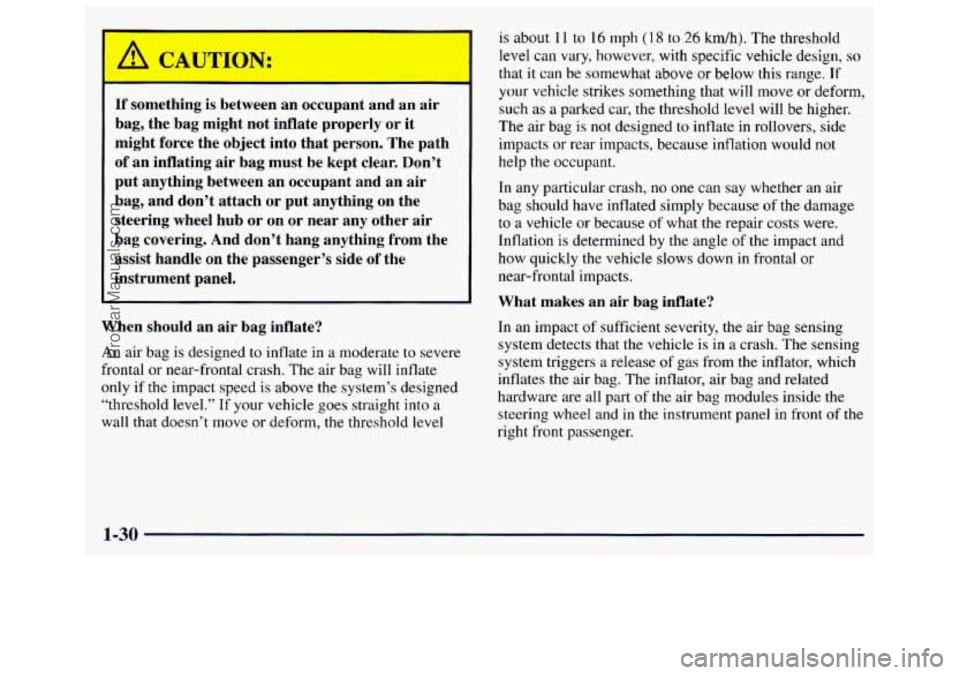1998 GMC SAVANA park assist
[x] Cancel search: park assistPage 38 of 388

If something is between an occupant and an air
bag, the bag might not inflate properly or it
might force the object into that person. The path
of an inflating air bag must be kept clear. Don’t
put anything between an occupant and an air
bag, and don’t attach or put anything on the
steering wheel hub
or on or near any other air
bag covering. And don’t hang anything from the
assist handle on the passenger’s side
of the
instrument panel.
When should an air bag inflate?
An air bag is designed to inflate in a moderate to severe
frontal or near-frontal crash. The air bag will inflate
only if the impact speed is above the system’s designed
“threshold level.”
If your vehicle goes straight into a
wall that doesn’t move or deform, the threshold level
is about 1 1 to 16 mph (18 to 26 km/h). The threshold
level can vary, however, with specific vehicle design,
so
that it can be somewhat above or below this range. If
your vehicle strikes something that will move or deform,
such as
a parked car, the threshold level will be higher.
The air bag
is not designed to inflate in rollovers, side
impacts or rear impacts, because inflation would not
help the occupant.
In any particular crash, no
one can say whether an air
bag should have inflated simply because of the damage
to a vehicle or because
of what the repair costs were.
Inflation
is determined by the angle of the impact and
how quickly the vehicle slows down in frontal
or
near-frontal impacts.
What makes an air bag inflate?
In an impact of sufficient severity, the air bag sensing
system detects that the vehicle
is in a crash. The sensing
system triggers a release
of gas from the inflator, which
inflates the air bag. The inflator, air bag and related
hardware
are all part of the air bag modules inside the
steering wheel and
in the instrument panel in front of the
right front passenger.
1-30
ProCarManuals.com
Page 88 of 388

Parking Lots
If you park in a lot where someone will be watching
your vehicle, it’s best to lock it up and take your keys.
But what if
you have to leave your ignition key? What if
you have to leave something valuable in your vehicle?
Put your valuables in a storage area, like your front
storage compartment.
Lock all the doors excePt the driver’s.
Passlock’
Your vehicle is equipped with the Passlock
theft-deterrent system.
Passlock is a passive theft-deterrent system. The system
is armed once the key is removed from the ignition.
Passlock enables fuel if the ignition lock cylinder is
turned with a valid key.
If a correct key is not used,
fuel is disabled. During
normal operation, the SECURITY light will go
off after the engine is started.
If the engine stalls and the SECURITY light flashes,
wait until the light stops flashing before trying to restart
the engine. Remember to release the key from the
START position as soon
as the engine starts.
If you are driving and the SECURITY light comes on, you
will be able
to restart the engine if you turn the engine off.
However, your Passlock system is not working properly
and must
be serviced by your dealer. Your vehicle is not
protected by Passlock at
this time. You may also want to
check the
fuse (see “Fuses and Circuit Breakers” in the
Index). See your dealer for service.
If the SECURITY light comes on while
the engine is
running, a problem has been detected and the system
may need service. See your dealer for service.
In an emergency, call the
GM Roadside Assistance
Center. See “Roadside Assistance” in the Index.
2-16
ProCarManuals.com
Page 383 of 388

Service and Appearance Care ...................... 6-1
Service and Owner Publications
.............. 8- 1 1. 8. 12
Service Publications
........................ 8- 1 1. 8. 12
Servicing Your
Air Bag-Equipped Vehicle ........... 1-32
Sheet Metal Damage
............................ 6-57
ShiftLever
............................... 2.21. 2.25
Shifting
Automatic Transmission
....................... 2-2 1
Into . Park (P) ................................. 2-25
OutofPark
.................................. 2-28
Sidemarker Lamp Bulb Replacement
............... 6-36
SignalingTurns
................................ 2-35
Skidding
...................................... 4-13
Specifications and Capacities
...................... 6-67
Speech Impaired. Customer Assistance
............... 8-4
Speedometer
................................... 2-52
Stains. Cleaning
................................ 6-52
Starter Switch Check
............................ 7-40
Starting Your Engine
............................ 2- 18
Steam ........................................ 5-12
Steering
....................................... 4-8
In Emergencies
............................... 4- 10
Power ....................................... 4-8
Speedsensitive
............................... 4-9
Tips
......................................... 4-9
Wheel. Tilt
.................................. 2-34
StorageAreas
.................................. 2-48
Storage. Vehicle
................................ 6-3 1
Stuck: In Sand. Mud. Ice or Snow .................. 5-36
Sunvisors
.................................... 2-49
Symbols. Vehicle
.................................. v
Shoulder Belt Height Adjuster ..................... 1 . 19 Taillamp
Bulb Replacement
...................... 6-37
TapePlayerCare
............................... 3-25
Temperature Control. Rear Passenger
................ 3-5
Theft
......................................... 2-15
Theft-Deterrent Feature
.......................... 3-21
Thermostat
.................................... 6-25
Third Gear. Automatic Transmission
................ 2-23
Tilt Steering Wheel
............................. 2-34
Time. Setting the
................................ 3-7
Tire Chains
.................................... 6-50
TireLoading ................................... 4-27
Tire-Loading Information Label
................... 4-27
Tires
......................................... 6-41
Alignment and Balance
........................ 6-48
BuymgNew
................................. 6-46
Chains
..................................... 6-50
Changing
a Flat .............................. 5-22
Cleaning
.................................... 6-57
Dual Operation
............................... 6-45
Inflation
.................................... 6-42
Inflation Check
............................... 7-38
Inspection and Rotation
........................ 6-43
Loading
.................................... 4-27
Pressure
.................................... 6-42
Temperature
................................. 6-48
Traction
.................................... 6-48
Treadwear
................................... 6-47
Uniform Quality Grading
....................... 6-47
Wear Indicators
.............................. 6-45
Wheel Replacement
........................... 6-49
When It’s Time for New
....................... 6-45
TopStrap ..................................... 1-51
9-9
ProCarManuals.com